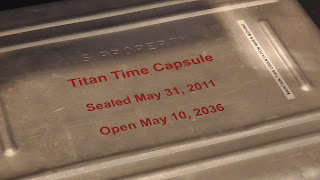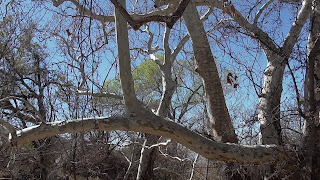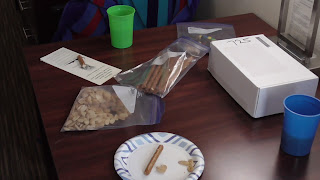Map for our 3-Day Site Seeing event...
Ready - Set - Go, put your thinking cap on!!!
Day 1 Part 1
This Titan Missile Museum is the only remaining Titan II site open to the public,
allowing you to re-live a time when the threat of nuclear war between the
U.S. and the former Soviet Union was a reality.

The Titan Missile National Historic Landmark is former Titan II launch complex 571-7.
This former operational missile site was originally part of the 571st Strategic
Missile Squadron (SMS), 390th Strategic Missile Wing (SMW),
Davis-Monthan Air Force Base (AFB), Arizona.
It is the sole remaining Titan II Intercontinental Ballistic Missile (ICBM)
omplex of the 54 that were “on alert” during the Cold War between 1963 and 1987.

During those 2 decades, there were 18 Titan II silo locations in the state of AZ,
(shown on the map above). Other Titan II facilities were located in Kansas & Arkansas.

The Titan II was capable of launching from its underground silo in 58 seconds and
could deliver a nine megaton thermonuclear warhead to its target
more than 6,000 miles away in less than thirty minutes.
For more than two decades, 54 Titan II missile complexes across the United States stood
“on alert” 24 hours a day, seven days a week, heightening the threat of nuclear war or
preventing Armageddon, depending upon your point of view.
Don evaluates the facts about the warhead located to his left...
and learned that it would inflict 3rd degree burns at a
distance of 25 miles !!!
Titan II was the largest and most powerful intercontinental
ballistic missile (ICBM) ever build by the United States.
(click on photo to enlarge) so you can learn more facts...
The Titan Time Capsule also captured our curiosity before
we headed outside to observe.
This is type of security vehicle that roamed the area.
The stage 1 engine developed 430,000 pounds of thrust.
That is about the same power as two 747's running at full throttle.
Close-up... Stage 1 burned until it ran out of propellant (about
2 1/2 minutes), then was jettisoned as stage 2 ignited. The
engine consumed about 25,000 gallons of propellant, about 170 gallons
per second, boosted the missile to an altitude of about
50 miles and propelled it about 50 miles toward the target.
Stage 2 Engine burned for about 3 minutes and propelled
the missile to an altitude of about 200 miles. It was shut
down at the appropriate time by the on-board guidance system.
When stage 2 separated from the missile, the re-entry vehicle,
which carried the nuclear weapon continued on toward the
target in a pre-planned ballistic trajectory. The re-entry vehicle
was the only part of the missile to actually reach the target.
To learn more about the butterfly valves and how they
were locked, click the photo to enlarge it!!!
Launch complex 571-7 came off alert on November 11, 1982.
Work to turn the missile site into a museum began in February of 1983,
The Titan Missile Museum opened its doors to the public on May 21, 1986.
Since opening its doors, the museum has hosted more than
1.5 million visitors from around the world.
The site was designated a National Historic Landmark in April of 1994,
in recognition of the important role that the Titan II played in American history.
There are fewer than 3,000 historic places in the United States that bear
this national distinction, and this status is rarely conferred on sites that
are less than 50 years old. Launch complex 571-7 was just
31 years old when it achieved its landmark status. It is further distinguished
by the fact that it is one of only two ICBM sites in the entire world
that have been preserved for the benefit of the public.
My brain needed a rest, how about yours?
Don stopped to do a couple of geocaches on the
way to Madera Canyon about 30 miles away. It is
located in the Santa Rita Mountains and is part of
Coronado Nat'l Forest.
The scenery was stunning as the road traversed thru 4 life zones:
Lower Sonoran (to 4500'); Upper Sonoran 4500'-6500';
Transition zone (6500'-8000') and the Canadian zone (8,000'-9500')
And, yes some of those lofty peaks include Douglas fir, white fir and
quaking aspen.
The two main draws to the canyon are hiking and bird
watching. To learn more about the trails checkout
www.friendsofmaderacanyon.org
Madera Canyon is also home to over 250 species of birds, including
15 hummingbird species. Visitors from all over the world arrive
in search of such avian specialties as the Elegant Trogon, (shown above)
Elf Owl, Sulphur-bellied Flycatcher, Red-faced Warbler
and Painted Redstart.
As we entered the canyon, Don found another geocache
at this ghost bike, a small & somber memorial for cyclists.
They are painted white and secured to an object near the crash site.
This ghost bike is a memorial to George "Fred" Dillemuth
1966-2019
Another geocache was called Green & Gold... this is
the Green... and
this was the Gold...
I was busy admiring the bark of the Arizona Sycamore tree
when something more interesting appeared....
I whistled and the deer became very alert
but decided the moist leaves were more interesting UMMMM.
I couldn't determine if he was a white tail or mule deer!!!
Both are prevalent in the canyon
In addition to camp grounds there were lots of lodging sites
and this one looked appealing to me. Well, it's time to head to our
camp site... the Best Western Green Valley AZ
No cooking tonight as this Best Western had an on site excellent
restaurant, and
a lovely pool to sit by and savor our days delights.
































No comments:
Post a Comment